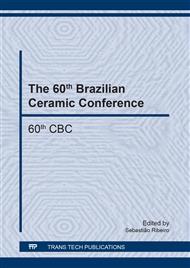p.207
p.212
p.218
p.224
p.230
p.234
p.240
p.245
p.251
Experimental Statistics Applied to Porous Ceramics Processing
Abstract:
Statistical techniques are particularly useful in the engineering, objecting the optimization of fabrication processes. This paper had the purpose of evaluating if the variables such as mechanical resistance, linear shrinkage, apparent porosity, density and water absorption are influenced by the amount of peat added to refractory clay, to ensure the porosity on the production of porous ceramics used as ceramic filters. In order to treat the data it was used the technique of variance analysis, with the regression analysis and the Scott-Knott test. According to the variance analysis, there were some differences between the treatments for all properties analyzed and, by the regression analysis, optimum peat levels were found for all properties analyzed, for some properties these levels were considered inadequate for being superior to the limit stablished.
Info:
Periodical:
Pages:
230-233
Citation:
Online since:
January 2018
Price:
Сopyright:
© 2018 Trans Tech Publications Ltd. All Rights Reserved
Share:
Citation:


